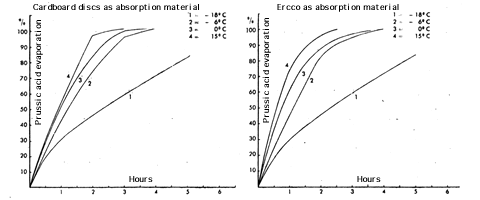| Text: Deutsch English |
 | Once More: The Efficiency of Prussic Acid at Low Temperatures |
||||||||
 |
 |
36
The previously noted quantities of Zyklon for the various experiments were cooled to the foreseen temperature for the experiment. As absorption material paper disks were used in one case, in another case erco cubes (highly porous gypsum material), that is the two most often used carrier materials in the implementation of prussic acid gassing. In order to get an overview of the entire temperature range, the experiments were carried out in the same order at -18° C, -6° C, 0° C, and +15° C.
In any event the calculation of relationships could not be made using this procedure in cases in which the humidity in the room is high thereby depositing upon the evaporating surfaces water or snow (depending upon the temperature) which significantly diminish the rate of evaporation.
Results of the experiments.
The resulting values are set out in the following tables and the diagrams further below:
![]()
Table 1
Release
of prussic acid from absorption in cardboard disks.
| Duration | -18 to -19° C | -6° C | 0° C | +15° C |
| after 1 hour | 32.5% | 50.0% | 62.6% | 77.0% |
| " 2 " | 45.0% | 84.1% | 90.7% | 96.8% |
| " 3 " | 60.5% | 95.7% | 98.0% | 100.0% |
| " 4 " | 72.0% | 100.0% | 100.0% | - |
| " 5 " | 84.0% | - | - | - |
![]()
Table 2
Release of
prussic acid from absorption in erco cubes.
| Duration | -18 to -19 C | -6 C | 0 C | +15 C |
| after 1 hour | 31.5% | 45.0% | 55.0% | 57.0% |
| " 2 " | 45.5% | 73.0% | 85.7% | 96.4% |
| " 3 " | 58.5% | 95.2% | 99.0% | 100.0% |
| " 4 " | 72.0% | 100.0% | 100.0% | - |
| " 5 " | 82.0% | - | - | - |
![]()

Illustration 1 Diagram.
*) From J.H
Perry and F. Porter. Journal of American Chemical Society 48, 299;
1926.
| Text: Deutsch English |
 | Once More: The Efficiency of Prussic Acid at Low Temperatures |
||||||||
Last modified: March 7, 2011
Technical/administrative contact: webmaster@holocaust-history.org